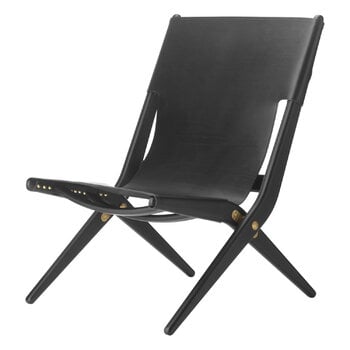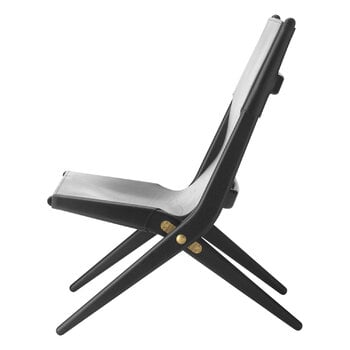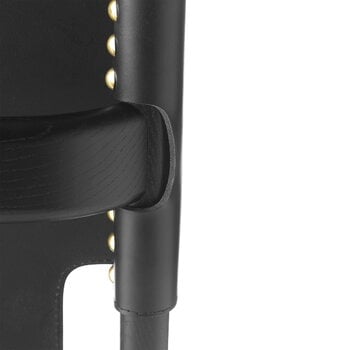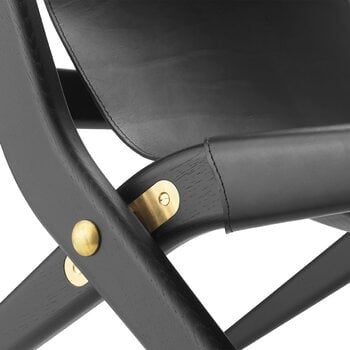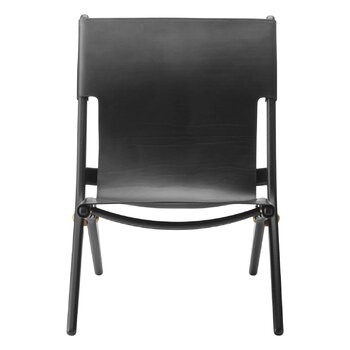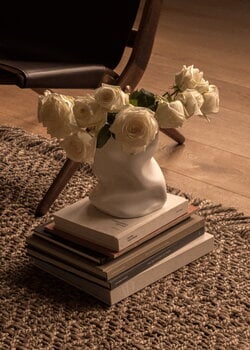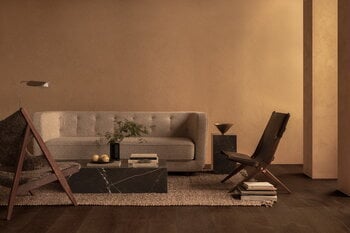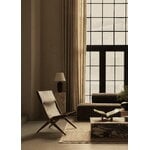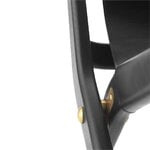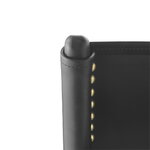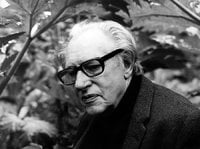Audo Copenhagen’s Saxe lounge chair was designed by architect Mogens Lassen in 1955 for The Copenhagen Cabinetmakers’ Guild Competition. The beautiful chair features a folding oak frame upholstered in leather. By Lassen brought the Saxe lounge chair, originally made by master joiner A. J. Iversen, back in production to celebrate the chair’s 60th anniversary. The timeless design continues to charm decade after decade.
Saxe lounge chair, black oak - black leather
Audo Copenhagen
Description
Audo Copenhagen’s Saxe lounge chair was designed by architect Mogens Lassen in 1955 for The Copenhagen Cabinetmakers’ Guild Competition. The beautiful chair features a folding oak frame upholstered in leather. By Lassen brought the Saxe lounge chair, originally made by master joiner A. J. Iversen, back in production to celebrate the chair’s 60th anniversary. The timeless design continues to charm decade after decade.
Product details (11)
- Colour
- Black
- Width
- 60 cm
- Depth
- 67 cm
- Height
- 84 cm
- Seat depth
- 35 cm
- Seat height
- 37 cm
- Seat material
- Black leather
- Base material
- Black stained oak
- Weight
- 13 kg
- Notes
- Please note that genuine leather is a natural material that requires maintenance and becomes even more beautiful if it is properly cared over time. The changes and stretch in the leather should be expected and is not seen as a product fault. The colour will get patina and change over time.
- Care instructions
- Do not place in direct sunlight or extreme heat. Do not use sharp objects on the leather. Core leather is a very receptive material and is therefore responsive for any kind of moisture. To care and clean core leather, only use leather treatment intended to core leather. For the oiled oak, please wipe with a moist cotton cloth.
- Product ID
Designer
The Danish architect Mogens Lassen (1901-1987) was a pioneer of Danish functionalism. In 1927 he left to work for an engineering company, but he did not enjoy the work nor speak French. Paris however changed Lassen’s view on architecture and when he returned to Denmark he established his own studio.
Along with working in architecture Lassen also designed furniture and other objects, and his Kubus candlestick has become an icon of Danish design. Lassen started designing the first Kubus long before it was first produced in 1962 - the Kubus candlesticks were not put on the market, and Lassen gave them to family members and friends. The grandchildren and grand-grandchildren of Lassen established the design company By Lassen in 2008 to honor the work of Mogens Lassen and his brother Flemming Lassen.
View all productsReviews (0)
Sustainability
The Product Sustainability Framework, our criteria of sustainable design, helps you find the most sustainable products in our selection. Read below which sustainability criteria this product has met.
Working conditions & labour 7/9
-
Equal opportunities for all employees
-
Commitment to UN Global Compact, fair compensation for all employees
-
Corporate responsibility requirements defined and communicated for suppliers
-
Systematic work for improved inclusion and well-being in the workplace
-
Transparent supply chain
-
Suppliers' compliance to a code of conduct ensured
-
Compliance to the UN Guiding Principles on Business and Human Rights ensured in the supply chain
-
Direct suppliers audited and certified
-
Support for community involvement in the supply chain
Eco-friendly production 8/9
-
Fair and resource-wise water-use in production
-
No incineration or landfilling of returned items
-
No use of endangered species as materials
-
No direct environmental emissions or waste (excl. GHGs) from production
-
The sustainability of direct suppliers' production is addressed and monitored
-
Production and material sourcing that respect biodiversity, animal rights, and natural ecosystems
-
Material-efficient and ecological packaging
-
No potentially harmful chemicals used in own production
-
Positive impact on nature’s well-being through operations that regenerate natural ecosystems
Climate impact 4/8
-
Company's direct greenhouse gas emissions identified and commitment to reduction
-
Product's carbon impact identified and commitment to reduction
-
Guidance on energy- and eco-efficient use of the product
-
Carbon footprint of the product calculated and goals set to reduce it
-
Contribution to climate initiatives beyond the brand’s direct operations
-
Low-carbon or compensated transportation
-
100 % renewable energy in own production and operations
-
Carbon neutral or carbon negative product
Sustainable materials 6/6
-
Sustainable and long-lasting material choices
-
No harmful or hazardous substances
-
Responsible raw material sourcing and production
-
Materials suited for circularity: monomaterials, recyclable finishings, renewable or recycled contents etc.
-
Ecological materials: natural, biodegradable, recyclable or recycled contents
-
Outstanding materials in terms of innovativeness, responsibility, sustainability and circularity: local production or sourcing, 100 % recycled content, C2C-certification etc.
Circular design 4/5
-
High aesthetic quality promoting long-term use of the product
-
Technically durable product design and material choices
-
Design for enduring life-long quality
-
Design and support for product maintenance, repair and upgradability
-
Innovative circular design solutions: circular service system, resale platform, remanufacturing, collection of used products, etc.
